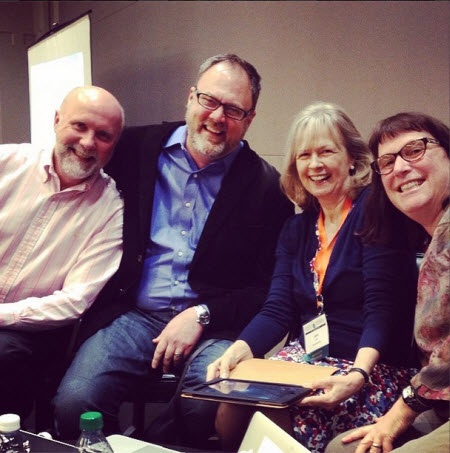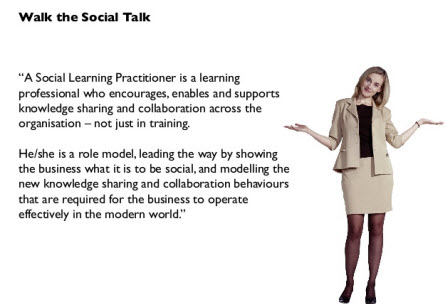
Last month, I had the pleasure of participating in National eXtension Conference which was amazing for many reasons. I first did several professional sessions with this network back in 2007 and an online class on knowledge sharing and online collaboration – so it was great to long-time colleagues. The highlight was a master panel with Dave Gray, Harold Jarche, and Jane Hart on connected learning and culture change needed to embrace this type of learning. We used Dave Gray’s “Board Thing” online tool to crowdsource questions to discuss from the audience. You can find a storify of the curated tweets and links here.
What was most exciting for me was to finally meet three people in person after following their writing, blogs, and books for almost a decade. If you are not already familiar with their work, you will learn a lot about online collaboration, knowledge management, informal learning, and networks by following them.
Dave Gray: Dave Gray is a guru on the topics of design, innovation, culture and change. He’s written two books – Gamestorming and The Connected Company. I first discovered Dave’s work through colleague, Eugene Eric Kim, who recently shared this great story about Dave and his work.
YES YES YES YES YES @davegray “People don’t learn from spreadsheets, predictions, and plans, they learn from making things” #NeXConf
— Jason Adam Young (@jasonadamyoung) March 27, 2014
[slideshare id=31984648&doc=ldg-webinar-140306053535-phpapp01]
Jane Hart: Jane has been blogging for many years and writes about informal and workplace learning . She is one of the leading voices of “social learning practice” which is about self-directed and informal learning from your online networks. She’s written a book about this, “The Social Learning Handbook.” She has a wonderful Twitter stream called “Learning Flow” that is a continuous learning stream of short activities (15-20 minutes) a day. She also publishes the Top Learning Tools Index, a crowdsourced list of the best technologies for networked learning.
In her keynote, Jane gave us the big picture and framework about what social learning is and why it is important. Jane described social learning as “learning the new” to keep up with our industry. It is about digesting a steady flow of information from a diverse online professional network. “It is about constantly looking around you and at new resources to learn new things.” She used the metaphor of white river rafting.
Why is learning the new important? She pointed out that an individual’s knowledge and skills will be out of date within 5 years and a college degree will be out of date long before the loan is paid off. This means we need to build the skill of learning the new and this means building online social network competence. Most importantly, it is about building a professional network of peole in your industry or professional area (external experts and others) and interacting with them to keep up to date.

What does learning the new mean for organizations? She explained that “learning or teaching the old” is about training, knowledge transfer, and structured, directed learning. Teaching the new is not structured because it is social learning. She points out that you can’t teach people to be social, only to show what it is and help facilitate it. She also talked about a new role called “Social Learning Practitioner,” someone who encourages and enables and supports knowledge sharing and learning across the organization.
Harold Jarche: I’ve been reading Harold Jarche’s blog for many years and was thrilled to finally meet in person. He is a network consultant and recently wrote an e-book, Seeking Perpetual Beta: A Guide Book for a Networked Era. In 2011, I read about his “Seek, Sense, Share” framework for personal knowledge management and adopted this approach for a year which was an invaluable for learning.
After Jane’s keynote, Harold lead a master class with practical exercises on how to “learn the new” or manage/design and use a professional learning network.
Mapping Your Professional Network Exercise:
He asked to think about this question: Who are the people with you have most frequently communicated with in order to get your work done? He asked us to list them. Then asked us to do analysis based on:
- Age
- Organization
- Gender
- Hierarchical Position
- Area of Expertise
- Geographic Location
He asked to reflect on our network map. Is your professional learning network diverse enough? Diversity correlates with innovation? Are you getting new ideas from your network? If you find Twitter boring, perhaps you are following wrong people. This sparked an excellent discussion about how we identify people to follow – how do we tune our network? Here’s a blog post from Jamie Seger summarizing some of the ideas into practice.

He also shared some points about how you need to filter your professional learning network. The illustration above is Jarche’s “Seek, Sense, Share” model that integrates Five forms of filtering by Tim Kastelle. The filtering approaches fall into two categories: Human Judgement Based or Mechanical.
The most important takeaway was to understand how to use human filtering in your professional network. You can identify the recognized experts on a topic, especially if it is a side topic to what you need to know and follow them. But if the topic is the core of your work, you need a network expert filter – this is multiple perspectives on the topic. This is about being intentional about selecting who you follow to build your ability to learn.
